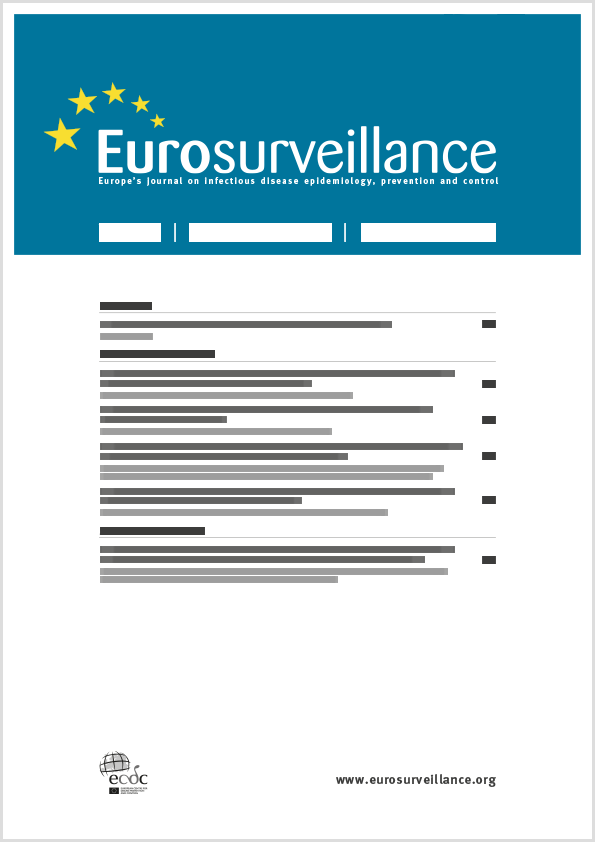- Home
- Eurosurveillance
- Previous Issues
- Volume 30, Issue 29, 24/Jul/2025
Eurosurveillance - Volume 30, Issue 29, 24 July 2025
Volume 30, Issue 29, 2025
- Surveillance
-
SDG 3: hepatitis
-
-
Prevalence and risk factors of active hepatitis C infection among at-risk migrant populations in Madrid, Spain, 2019 to 2023
More LessBACKGROUNDHepatitis C virus (HCV) microelimination among at-risk migrants supports global elimination goals.
AIMTo evaluate risk factors, prevalence and trends of active HCV infection among at-risk migrants screened for HCV in Madrid from 2019–23.
METHODSAt-risk migrants (born outside Spain, living in country < 10 years regardless of legal status), were screened for HCV via mobile units with rapid antibody testing, and confirmed by RNA testing. Recruitment of this convenience sample focused on migrant centres, shelters, harm reduction centres and social service sites. Primary outcome was active HCV prevalence. Risk factors analysed included origin, alcohol use, no stable income, drug use and sexual behaviour. Data were analysed using general linear models with negative binomial distribution and p values adjusted for multiple comparisons (q values).
RESULTSAmong 2,288 migrants, 6.5% (149/2,288) had anti-HCV antibodies, 47.0% (70/149) of whom tested positive for HCV-RNA; 81.4% (57/70) began antiviral therapy. Overall prevalence of active HCV infection was 3.1% (70/2,288). Injection drug use (non-active vs never used (aIRR: 7.3; 95% CI: 2.7–12.7) and active (aIRR: 14.7; 95% CI: 6.7–32.1)), European origin (vs non-European; aIRR: 5.8; 95% CI: 2.7–12.7) and alcohol misuse (vs no misuse; aIRR: 1.8; 95% CI: 1.1–2.9) were main risk factors. Prevalence showed no significant change during 2019–23 in the overall population and across risk groups.
CONCLUSIONAt-risk migrants screened in Madrid had a high prevalence of active HCV infection. This is higher than reported estimates for the general Spanish population and supports the need to enhance targeted HCV prevention, screening and treatment strategies among migrant populations.
-
- Top
- Research
-
SDG 3: hepatitis
-
-
National representative seroprevalence of viral hepatitis B, C, and D seromarkers in Ukraine, 2021
More LessBACKGROUNDAligned with World Health Organization (WHO) goals, Ukraine aims to eliminate viral hepatitis. While some data on viral hepatitis B and C prevalence exist among key populations, nationwide prevalence in the general population has never been assessed.
AIMTo assess the prevalence of viral hepatitis B, C, and D seromarkers in Ukraine in 2021 to plan and monitor elimination measures.
METHODSBlood samples available from a cross-sectional household-based SARS-CoV-2 serosurvey conducted in 2021 were tested for hepatitis C virus (HCV) antibodies, total antibodies against hepatitis B virus (HBV) core antigen (HBc), hepatitis B surface antigen (HBsAg) and hepatitis D virus (HDV) antibodies. We calculated crude and weighted proportions for anti-HCV, anti-HBc and HBsAg positivity. To account for differences in sex, age group and urbanisation level, we applied post-stratification weights using inverse probability weighting based on the distribution of the Ukrainian population. We calculated proportions positive for anti-HDV among HBsAg-positive cases and weighted regional estimates for HBV and HCV seromarkers.
RESULTSWeighted prevalence of anti-HCV was 3.3% (95% CI: 2.8–4.0), anti-HBc 11.6% (95% CI: 10.8–12.5) and HBsAg 0.9% (95% CI: 0.7–1.2). Among HBsAg-positive individuals, 7.5% (95% СI: 3.0–17.9) were anti-HDV positive. We found higher prevalence of HBV and HCV seromarkers among men and in southern Ukraine.
CONCLUSIONHBsAg prevalence and considerably high anti-HBc and anti-HCV prevalence indicate substantial lifetime exposure. This reinforces the necessity of sustained prevention such as HBV vaccination of newborns and groups at increased risk, regular hepatitis B and C screening, early treatment, and raising awareness to reduce ongoing transmission.
-
Volumes & issues
-
Volume 30 (2025)
-
Volume 29 (2024)
-
Volume 28 (2023)
-
Volume 27 (2022)
-
Volume 26 (2021)
-
Volume 25 (2020)
-
Volume 24 (2019)
-
Volume 23 (2018)
-
Volume 22 (2017)
-
Volume 21 (2016)
-
Volume 20 (2015)
-
Volume 19 (2014)
-
Volume 18 (2013)
-
Volume 17 (2012)
-
Volume 16 (2011)
-
Volume 15 (2010)
-
Volume 14 (2009)
-
Volume 13 (2008)
-
Volume 12 (2007)
-
Volume 11 (2006)
-
Volume 10 (2005)
-
Volume 9 (2004)
-
Volume 8 (2003)
-
Volume 7 (2002)
-
Volume 6 (2001)
-
Volume 5 (2000)
-
Volume 4 (1999)
-
Volume 3 (1998)
-
Volume 2 (1997)
-
Volume 1 (1996)
-
Volume 0 (1995)
Most Read This Month

-
-
Detection of 2019 novel coronavirus (2019-nCoV) by real-time RT-PCR
Victor M Corman , Olfert Landt , Marco Kaiser , Richard Molenkamp , Adam Meijer , Daniel KW Chu , Tobias Bleicker , Sebastian Brünink , Julia Schneider , Marie Luisa Schmidt , Daphne GJC Mulders , Bart L Haagmans , Bas van der Veer , Sharon van den Brink , Lisa Wijsman , Gabriel Goderski , Jean-Louis Romette , Joanna Ellis , Maria Zambon , Malik Peiris , Herman Goossens , Chantal Reusken , Marion PG Koopmans and Christian Drosten
-
- More Less


